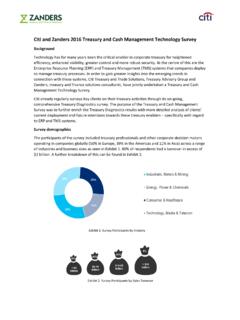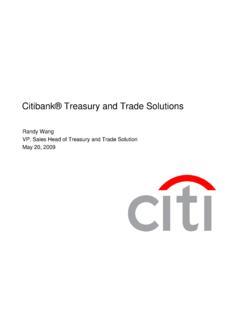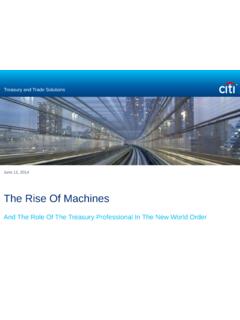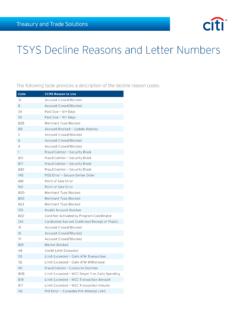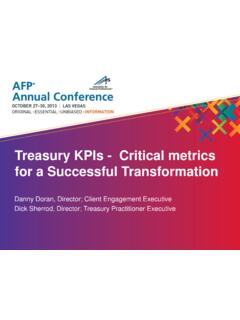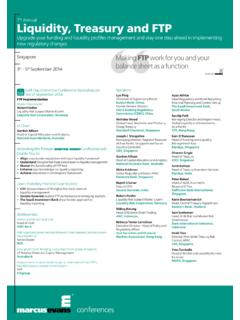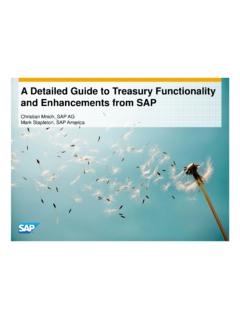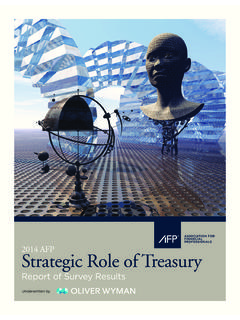Transcription of ESSENTIALS OF TREASURY trEasury MANAGEMENT …
1 ESSENTIALS OFTREASURY MANAGEMENTFOURTH EDITIONT able of ContentsEssEntials of TREASURY ManagEMEntfourth EditionCtP Body of KnowlEdgE thE gloBal standard in CorPoratE trEasuryESSENTIALS OFTREASURY MANAGEMENTFOURTH EDITIONT able of Contents1 PART I Introduction to the Study of TREASURY ManagementINTRODUCTIONI. IntroductionII. The Evolving Role of the TREASURY ProfessionalIII. Organization of ESSENTIALS of TREASURY ManagementIV. SummaryCHAPTER 1: THE ROLE OF TREASURY MANAGEMENTI. IntroductionII. The Role and Organization of TREASURY ManagementA. Overall Goal and ObjectivesB. TREASURY Operations/Cash ManagementC. Bank Relationship ManagementD. Reporting and Information SharingIII. Finance and TREASURY OrganizationA.
2 Financial Professionals in an OrganizationB. TREASURY Organizational StructureIV. Corporate GovernanceA. The Challenges of Corporate GovernanceB. Role of the Board of Directors in TREASURY OperationsC. Role of Independent DirectorsV. SummaryPART IIThe TREASURY MANAGEMENT EnvironmentCHAPTER 2: REGULATORY AND LEGAL ENVIRONMENTI. IntroductionII. General Regulatory EnvironmentA. General Types of Financial Institution (FI) RegulationsB. Issues Affecting Financial RegulationIII. Primary Regulators and Standard Setters of Global Financial MarketsA. Central BanksB. Financial Stability Board (FSB)C. Bank for International Settlements (BIS)D. Basel Committee on Banking Supervision (BCBS)E. European Payments Council (EPC) and SEPAF.
3 European Securities and Markets Authority (ESMA)G. International Association of Deposit Insurers (IADI)H. International Organization of Securities Commissions (IOSCO)I. Financial Action Task Force (FATF)J. International Association of Insurance Supervisors (IAIS)IV. Legal and Regulatory EnvironmentA. Regulatory AgenciesB. Legal EnvironmentESSENTIALS OFTREASURY MANAGEMENTFOURTH EDITIONT able of Contents1 ESSENTIALS OFTREASURY MANAGEMENTFOURTH EDITIONT able of Contents2V. Tax ConsiderationsA. Unitary Taxes and Foreign Tax CreditsB. Capital TaxC. Asset Tax and Turnover TaxD. Withholding TaxE. Sales and Use TaxF. Other TaxesVI. Bankruptcy (Insolvency) LawsA. Critical Issues in a Business Bankruptcy DecisionB. Bondholders RightsC.
4 Shareholders RightsD. Types of Bankruptcy in the Formal versus Informal Bankruptcy ProceduresVII. SummaryAppendix : SEPA Member StatesCHAPTER 3: BANKS AND FINANCIAL INSTITUTIONSI. IntroductionII. Financial Institutions: Functions and ServicesA. Global FIsB. Commercial BanksC. Investment Banks and Brokerage FirmsD. Credit UnionsE. Special Purpose Financial InstitutionsIII. SummaryCHAPTER 4: PAYMENT SYSTEMSI. IntroductionII. Payment Systems OverviewA. Basic PaymentsB. The Payment ProcessC. Settlement versus FinalityD. Types of PaymentsIII. Cash PaymentsIV. Check-Based PaymentsA. On-Us Check ClearingB. Transit Check ClearingC. Foreign ChecksD. EndpointsE. Deadlines and Deposit TimingF. Availability SchedulesG.
5 Balances and FloatH. Other Check-Processing Factors That Influence AvailabilityI. Additional Paper-Based InstrumentsV. Large-Value Electronic Funds Transfer (EFT)/Wire Transfer SystemsA. Real-Time Gross Settlement (RTGS) SystemsB. Clearing House Interbank Payments System (CHIPS)C. TARGET2 and the Single Euro Payments Area (SEPA)D. Continuous Linked Settlement (CLS)E. Society for Worldwide Interbank Financial Telecommunication (SWIFT) ESSENTIALS OFTREASURY MANAGEMENTFOURTH EDITIONT able of Contents3VI. Small-Value Transfer or Automated Clearinghouse (ACH) SystemsVII. Card-Based Payment SystemsA. Credit CardsB. Debit Cards/EFTPOS C. Other Varieties of Payment CardsD. Payment Card Industry Data Security Standard (PCI DSS)E. Merchant Card FeesVIII.
6 SummaryCHAPTER 5: MONEY MARKETSI. IntroductionII. Global Money Markets A. Money Market ParticipantsB. Investment Risk Considerations C. Types of Money Market Instruments and InvestmentsIII. Short-Term Money Markets in the United StatesA. Processing and Clearing of Short-Term Investments in the Money Market ParticipantsC. Federal Agency and Government-Sponsored Enterprise (GSE) SecuritiesD. Municipal Notes, Variable Rate Demand Obligations (VRDOs) and Tax-Exempt Commercial Paper (CP)IV. SummaryCHAPTER 6: CAPITAL MARKETSI. IntroductionII. Overview of Capital MarketsA. The Basics B. Key ParticipantsC. Division of the Capital MarketsD. Security Exchanges and Over-the-Counter (OTC) Markets III. Debt Market A. Medium- and Long-Term BorrowingB.
7 Other Factors in Using Debt as a Source of CapitalIV. Equity (Stock) SecuritiesA. Common StockB. Preferred StockC. Hybrid SecuritiesD. Depositary Receipts (DRs)V. SummaryAppendix : Listing of the World s Top 10 Stock ExchangesCHAPTER 7: RELATIONSHIP MANAGEMENT AND VENDOR SELECTIONI. IntroductionII. Relationship ManagementA. Number of Bank RelationshipsB. DocumentationC. Performance Measurement and EvaluationESSENTIALS OFTREASURY MANAGEMENTFOURTH EDITIONT able of Contents4 III. Vendor Selection and the Request for Proposal (RFP) ProcessA. Getting StartedB. RFP DesignC. RFP AdministrationIV. Bank Compensation PracticesA. Billing for Bank ServicesB. Value DatingC. Account Analysis in the US Commercial Banking SystemD. Comparing and Monitoring Costs among Financial Services ProvidersV.
8 Assessing Service Provider RiskA. Assessing Operational Risk for Service ProvidersB. Assessing Financial Services Provider (FSP) RiskC. Sovereign and Political RiskD. Managing Confidential Information and Conflicts of InterestE. Legal and Ethical IssuesVI. SummaryPART IIIW orking Capital ManagementCHAPTER 8: INTRODUCTION TO WORKING CAPITAL MANAGEMENTI. IntroductionII. Overview of Working CapitalA. Operating Cash Flows and TimelinesB. Float III. The Working Capital Cash Conversion Cycle (CCC)A. Days Inventory or Inventory Conversion PeriodB. Days Receivables or Receivables Conversion PeriodC. Days Payables or Payables Conversion PeriodD. Calculating the Cash Conversion Cycle (CCC)E. Evaluating the Impact of Changes to the Cash Flow TimelineIV.
9 How Changes in Current Accounts Impact External FinancingA. Changes in Current AssetsB. Changes in Current LiabilitiesC. External Financing RequirementsV. Working Capital Investment and Financing StrategiesA. Current Asset Investment StrategiesB. Current Asset Financing StrategiesESSENTIALS OFTREASURY MANAGEMENTFOURTH EDITIONT able of Contents5VI. MANAGEMENT of Credit and Accounts Receivable (A/R)A. Relationship Between TREASURY and Credit ManagementB. trade Credit PoliciesC. Billing and Collection MethodsD. Forms of Credit ExtensionE. Cash ApplicationF. Considerations Pertaining to Terms of SaleG. Financing Accounts Receivable (A/R)VII. MANAGEMENT of Inventory A. Elements of Basic Inventory PolicyB. Inventory Financing AlternativesVIII.
10 MANAGEMENT of Accounts Payable (A/P)A. Disbursement System Considerations B. Types of A/P and Disbursement SystemsIX. Multi-national Working Capital MANAGEMENT Tools A. Multicurrency Accounts B. NettingC. Leading and LaggingD. Re-InvoicingE. Internal FactoringF. In-house BankingG. Export Financing X. SummaryCHAPTER 9: WORKING CAPITAL METRICSI. IntroductionII. Basic Financial ConceptsA. Time Value of MoneyB. Opportunity CostC. Cost of CapitalIII. Fundamental Working Capital MetricsA. Current Ratio B. Quick RatioC. Cash Flow to Total Debt Ratio D. Total Working CapitalIV. Calculation of the Cash Conversion Cycle (CCC)A. Days Sales in Inventory (DSI) B. Days Receivables (DR)C. Days Payables (DP or DPO- Days Payables Outstanding)D.
